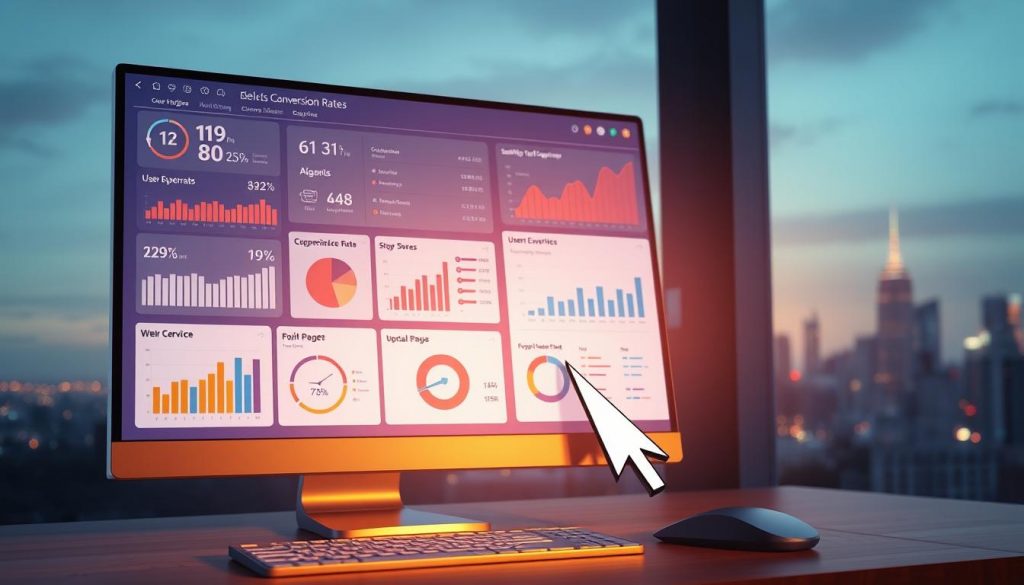Ever wondered why some businesses thrive while others struggle to attract customers? The secret often lies in understanding and optimizing one critical metric: conversion rate. Whether you’re running an online store, a service-based business, or a mobile app, improving this number can transform your results.
Conversion rate is calculated by dividing the number of conversions by the total ad interactions, expressed as a percentage. For example, if your ad receives 1,000 clicks and generates 50 sales, your conversion rate is 5%. This simple formula holds the key to unlocking better performance for your campaigns1.
Small changes can lead to big improvements. Take Expedia, for instance. By removing just one field from their checkout form, they increased profits by $12 million. Similarly, the travel company Going saw a 104% month-over-month increase in their homepage conversion rate by tweaking their call-to-action wording1.
Understanding these metrics is essential for optimizing your campaigns and improving overall business performance. With the right tools and strategies, you can turn clicks into loyal customers.
Key Takeaways
- Conversion rate is calculated by dividing conversions by total ad interactions.
- Small changes, like simplifying forms, can lead to significant improvements.
- Optimizing call-to-action wording can boost results dramatically.
- Tracking tools provide valuable data to refine your strategies.
- Even minor adjustments can have a major impact on business success.
Understanding Conversion Rate Fundamentals
What makes some campaigns outperform others? It often comes down to one key metric. This metric helps us measure how effectively our efforts turn visitors into customers. Let’s break it down.
Defining Conversion Rate and Its Importance
At its core, this metric represents the percentage of users who complete a desired action. Whether it’s signing up for a newsletter or making a purchase, it’s a clear indicator of campaign success2.
For example, if 500 people click on an ad and 25 make a purchase, the percentage is 5%. This simple calculation helps us evaluate the performance of our advertising efforts2.
Understanding this number is crucial. It allows us to compare different channels and identify areas for improvement. Tools like Google Analytics make tracking these events straightforward3.
How Conversion Rates are Calculated
The formula is straightforward: divide the number of conversions by the total number of visitors, then multiply by 100. This gives us the percentage3.
For instance, if a website has 10,000 visitors and 200 signups, the percentage is 2%. This method applies across industries, from e-commerce to service-based businesses2.
Industry benchmarks vary. Electronics websites often see higher percentages, while industrial equipment sites may perform lower. Knowing these averages helps set realistic goals2.
| Industry | Average Percentage |
|---|---|
| Electronics | 5% |
| Business Services | 4% |
| Industrial Equipment | 2% |
Small changes can lead to big improvements. Simplifying forms or tweaking calls to action can boost results significantly. For more insights, check out our guide on conversion rate fundamentals.
Key Factors Impacting Conversion Rates
What drives users to take action on your website or app? The answer lies in understanding the key factors that influence their decisions. From the way your platform looks to where your traffic comes from, every detail matters.
User Experience and Messaging
A well-designed user experience keeps visitors engaged. Clear messaging helps them understand what you offer. For example, simplifying forms can boost results by reducing distractions4.
Small changes, like improving layout or tweaking calls to action, can make a big difference. Live chat support also enhances engagement, leading to better outcomes4.

The Role of Traffic Sources and Channel Variation
Not all traffic is created equal. Organic and paid channels often perform differently. High-quality leads are more likely to take the desired action5.
Tracking these variations helps refine your strategy. For instance, offering multiple payment options can cater to diverse preferences, improving overall performance4.
Understanding these factors ensures your efforts lead to meaningful results. By focusing on user experience and traffic quality, you can drive better outcomes for your business.
Expert Tips and Proven Strategies for Conversion Rate Optimization
What separates successful campaigns from the rest? It’s often the ability to turn insights into actionable strategies. Small tweaks can lead to significant improvements, and we’re here to guide you through the process.
Actionable Strategies to Improve Performance
Start by simplifying your forms. Reducing the number of fields can increase sign-ups by almost 17%6. Next, focus on your call-to-action (CTA). Changing a CTA from “Contact us” to “Inquire now” improved clicks by 44.11%6.
Trust signals, like security badges, also play a crucial role. They significantly influence purchase decisions, especially in industries like fashion and automotive7.
Real World Examples and Case Studies
Take Bombas, for example. They updated their login CTA from an icon to text, resulting in a 4.1% increase in orders placed8. Another case is China Expat Health, which saw a 79% boost in lead conversion through A/B testing8.
These examples show how small changes can lead to big results. Whether it’s a layout change or a headline tweak, every detail matters.
Leveraging A/B Testing for Campaign Success
A/B testing is a game-changer. It helps identify what works best for your audience. For instance, testing a headline with a time-specific benefit led to a 9.52% increase in conversions6.
Multivariate testing takes it a step further. It examines how multiple elements interact to influence outcomes. This approach is essential for refining your strategies and achieving long-term success.
For more insights on optimizing your campaigns, explore our guide on affiliate marketing strategies.
Implementing Conversion Tracking and Performance Analytics
How can you ensure your marketing efforts are driving real results? The answer lies in tracking and analyzing user behavior. By using the right tools and strategies, we can turn raw data into actionable insights for growth.
![]()
Tools and Best Practices for Conversion Tracking
Google Analytics is a go-to solution for many marketers, with 90% relying on it for website tracking9. Its latest version, GA4, offers unlimited event tracking, compared to the 20-goal limit in Universal Analytics9. This flexibility allows us to monitor every click and event systematically.
For example, GA4 counts a key event every time it occurs. If a form is submitted twice in a session, it will log two events9. This level of detail helps us understand user behavior and identify areas for improvement.
Another powerful tool is Adjust, which provides real-time data across channels. By integrating these platforms, we can optimize our campaigns and enhance user engagement on our app and website.
Integrating Data Insights for Continuous Improvement
Data integration is key to refining our strategies. For instance, GA4 offers two counting methods for non-purchase events: “Once per event” and “Once per session”9. Using the latter can prevent inflated numbers, giving us a clearer picture of performance.
We can also assign static values to key events. A form submission, for example, might be valued at £1009. This approach helps us measure the true impact of our efforts on the bottom line.
Regular monitoring and A/B testing are essential. By testing different elements, we can determine which variations yield better results10. This continuous improvement process ensures our marketing efforts remain effective and aligned with industry benchmarks.
Conclusion
Mastering the art of turning visitors into loyal customers is the key to sustainable growth. By understanding and optimizing key metrics, businesses can unlock their full potential. Small changes, like simplifying forms or refining calls to action, can lead to significant improvements11.
Continuous testing and data analysis are essential. Tools like Google Analytics provide valuable insights into user behavior, helping identify areas for improvement12. A/B testing, for example, can reveal which variations perform best, driving better results over time13.
We’re committed to leveraging expert strategies and reliable data to maximize every interaction on your app or website. By monitoring campaigns closely and applying these insights, you can achieve tangible success in your marketing efforts.
Start implementing these techniques today. Use proven tools and methodologies to track progress and refine your approach. The journey to better performance begins with a single step.
FAQ
What is a conversion rate, and why does it matter?
How is a conversion rate calculated?
What factors can impact our conversion rate?
How can we improve our conversion rate?
What tools can help us track conversions effectively?
Can you share a real-world example of conversion rate optimization?
How does A/B testing contribute to campaign success?
Why is tracking performance analytics important?
Source Links
- How to increase conversion rates: 26 effective tips and strategies – https://unbounce.com/conversion-rate-optimization/how-to-increase-conversion-rate/
- Conversion Rate: What Is It & How to Calculate It | Mailchimp – https://mailchimp.com/marketing-glossary/conversion-rates/
- Understanding Conversion Rates in Digital Marketing | Institute of Data – https://www.institutedata.com/us/blog/conversion-rates-in-digital-marketing/
- Factors for conversion rate optimization – Desifer – https://desifer.se/insights/factors-for-conversion-rate-optimization/
- 10 Factors that Impact Your Lead-to-Opportunity Conversion Rate – https://www.newbreedrevenue.com/blog/factors-of-lead-to-opportunity-conversion-rate
- Top 20 Conversion Rate Optimization Tips | VWO – https://vwo.com/conversion-rate-optimization/conversion-rate-optimisation-tips/
- Ecommerce Conversion Rate Optimization: Proven Strategies That Drive Measurable Growth – https://project-aeon.com/blogs/ecommerce-conversion-rate-optimization-proven-strategies-that-drive-measurable-growth?hsLang=en
- Conversion Rate Optimization (CRO): 8 Ways To Get Started – https://blog.hubspot.com/marketing/conversion-rate-optimization-guide
- How to Set Up and Track Key Events (Conversions) in Google Analytics 4 – Ruler Analytics – https://www.ruleranalytics.com/blog/analytics/google-analytics-conversion-tracking/
- Best Practices for Conversion Tracking and CRO | Simple Machines Marketing – https://www.simplemachinesmarketing.com/blog/best-practices-for-conversion-tracking-and-cro/
- What is Conversion Rate? Formula and Tips to Improve it – https://www.youngurbanproject.com/what-is-conversion-rate/
- Conversion rate optimization – https://nielseniq.com/global/en/info/conversion-rate-optimization/
- How to Measure and Maximize Your ROI Using Conversion Rate KPI? – https://www.profit.co/blog/kpis-library/how-to-measure-and-maximize-your-roi-using-conversion-rate-kpi/




0 Comments